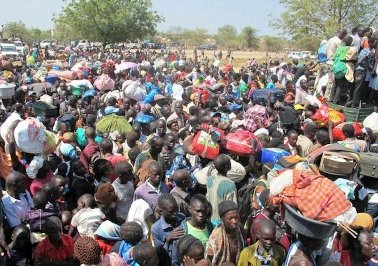Nearly half of S. Sudan’s population need food assistance: report
February 27, 2018 (JUBA) – More than 5 million people in South Sudan urgently need food assistance, the global humanitarian organization, CARE warned on Monday.

Particularly at risk, it said, are 155,000 people, including 29,000 children, who are likely to suffer from the most extreme levels of hunger.
Last month, 5.3 million people were already struggling to find enough food each day and were in “crisis” or “emergency” levels of food insecurity (IPC Phases 3 and 4), the newly-released Integrated Food Security Phase Classification (IPC) report stated.
Jointly issued by the Food and Agriculture Organization of the United Nations (FAO), the United Nations Children’s Fund (UNICEF) and the World Food Programme (WFP), the new report warned that progress made to prevent people from dying of hunger could be undone, and more people could be pushed into severe hunger and famine-like conditions during May-July if assistance and access are not made.
“What we’re witnessing is beyond human imagination. We’ve seen the hunger in South Sudan get worse every year, and every year agencies like CARE do their best to respond,” says Rosalind Crowther, CARE’s country director in South Sudan.
“But the needs keep growing and we’re seeing more hunger in more places. We’re especially seeing a significant increase in malnutrition among children in communities where CARE is working,” added the official.
Since last year, the country has witnessed escalating conflict, which has forced many South Sudanese to flee their homes. Many farmers have abandoned their fields for the same reason. It is projected that South Sudan will have a deficit of estimated cereal needs in 2018 measuring 482,000 metric tons.
So far, CARE said it has distributed more than $13 million in food assistance to more than 500,000 people in Unity, Jonglei, Upper Nile and Eastern Equatorial states in the past 12 months. Still, this remains a drop in a relentlessly expanding ocean.
“Our resources are stretched,” says Crowther. “There’s an urgent need for donors and the humanitarian community to step up our assistance so we can reach more people. If we don’t, the repercussions could be catastrophic.”
Since the conflict began in December 2013, more than 4 million South Sudanese have fled their homes. Nearly 90 percent of the forcibly displaced are women and children and nearly 65 percent are under 18. Also, more than 2 million have sought refuge in neighboring countries, but nearly the same number of people remain in South Sudan, living in host communities or Protection of Civilian (PoCs) sites.
(ST)
